Sweet Corn IPM Newsletter No. 6- August 5, 2021
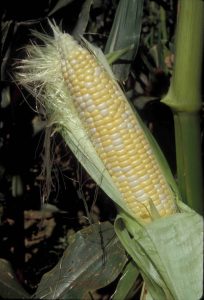
Sweet Corn IPM Newsletter No. 6- August 5, 2021
Click on photos to enlarge.
CORN EARWORM AND FALL ARMYWORM NUMBERS LOW
Western Bean Cutworm Numbers Higher; May Threaten Silking Corn
SITUATION
Corn development and harvest slowed this week with more rain and cooler temperatures though much of the state. Predicted warmer temperatures on the coming days should advance growth and maturity rapidly in later plantings. The weather also seems to have slowed the development of insect pest problems in corn. Most fields are seeing little, if any damage at this point, although the warmer weather may bring increased pest pressure.
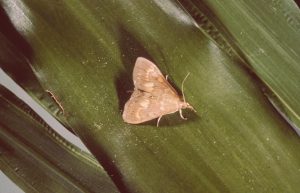
European corn borer:
None of the fields we scouted were over the 15% control threshold for feeding activity this week. European corn borer moth trap counts were over the spray threshold of 5/week in silking corn at sites in Monmouth, Sabattus and Dayton.

Corn earworm:
Moth captures in pheromone traps continue to be very low throughout the state; only two sites: New Gloucester and one Wells field, have a recommended 6-day spray interval to protect against corn earworm in silking fields. No other sites required control of corn earworm at this time. However, predicted warmer, drier weather may increase moth activity soon.
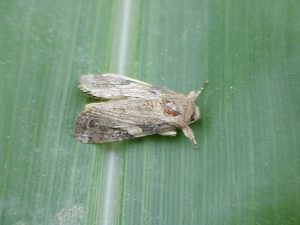
Fall armyworm:
Moths counts were very low in most locations, but four sites were over the threshold of 3 moths per week in silking corn. Sprays to protect silking corn were recommended at: Monmouth, Wayne and one Dayton site. The New Gloucester site was also over the threshold for fall armyworm, but is protected with the spray schedule recommended for corn earworm. No feeding damage has been found in the fields, but we expect to see it soon.
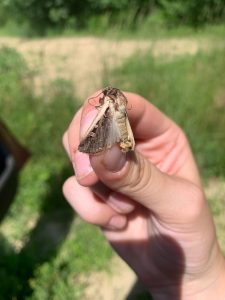
Western Bean Cutworm:
Moths are widespread and counts continue to be high in our pheromone traps, ranging from 3 to 58 at sites around the state. The threat this “new” pest poses is thought to be similar to fall armyworm. We are recommending protecting corn when feeding damage reaches 8% in a field, or when moths are active in silking fields, which is the case at most locations this week.
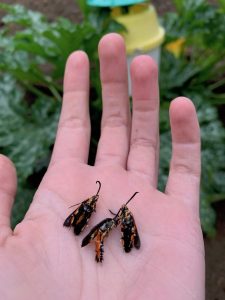
Squash vine borer:
Moths captured in pheromone traps were lower this week at all locations. No traps were over the threshold of 5 per week, so no sprays were recommended. Growers should remain on the lookout for feeding at the base of the plants and/or wilting vines, and apply appropriate control if damage is found.

Powdery mildew has been found on squash and pumpkins around the state this week. There are numerous fungicides available for managing this fungal disease. See the New England Vegetable Management Guide for details. Start fungicide applications when symptoms (gray powdery spots on leaves) are just beginning to develop or when fruit are starting to enlarge. The IPM action threshold is 1 of 50 older leaves showing symptoms (e.g. gray spots on the leaf surface). Look at the lower as well as upper surface of leaves when scouting. Use a 14-day spray interval with resistant varieties; 7-day with other varieties. Rotate the fungicide family (FRAC group) used often to prevent resistance development.
Sincerely,
David T. Handley
Vegetable & Small Fruit Specialist
Highmoor Farm Pest Management Unit
P.O. Box 179 17 Godfrey Drive
52 U.S. Route 202 Orono, ME 04473
Monmouth, ME 04259
207.933.2100 1.800.287.0279
| Location | CEW
Moths |
ECB
Moths |
FAW
Moths |
%Feeding
Damage |
Recommendations / Comments |
|---|---|---|---|---|---|
| Auburn | 0 | 1 | 0 | 0% | No spray recommended |
| Biddeford | 1 | 0 | 1 | 4% | No spray recommended |
| Bowdoinham | 0 | 0 | 0 | 1% | No spray recommended |
| Cape Elizabeth | 0 | 1 | 0 | 1% | No spray recommended |
| Dayton I | 0 | 7 | 0 | 1% | One spray for ECB on silking corn |
| Dayton II | 1 | 12 | 3 | 7% | One spray for ECB+FAW on silking corn |
| Farmington | 0 | 0 | 1 | 0% | No spray recommended |
| Garland | 0 | 0 | 2 | 0% | No spray recommended |
| Lewiston | 0 | 0 | 1 | 0% | No spray recommended |
| Monmouth | 1 | 24 | 3 | 2% | One spray for ECB+FAW on silking corn |
| New Gloucester | 2 | 1 | 41 | 0% | 6-day spray interval for silking corn |
| Oxford | 0 | 0 | 2 | 4% | No spray recommended |
| Palmyra | 0 | 0 | 0 | 0% | No spray recommended |
| Sabattus | 0 | 6 | 0 | 0% | One spray for ECB on silking corn |
| Wayne | 0 | 0 | 3 | 0% | One spray for FAW on silking corn |
| Wells I | 1 | 2 | 2 | 1% | No spray recommended |
| Wells II | 3 | 3 | 0 | 1% | 6-day spray interval for silking corn |
CEW: Corn earworm (Only fresh silking corn should be sprayed for this insect.)
ECB: European corn borer
FAW: Fall armyworm
| Moths caught per week | Moths caught per night | Spray interval |
|---|---|---|
| 0.0 to 1.4 | 0.0 to 0.2 | No spray |
| 1.5 to 3.5 | 0.3 to 0.5 | Spray every 6 days |
| 3.6 to 7.0 | 0.6 to 1.0 | Spray every 5 days |
| 7.1 to 91 | 1.1 to 13.0 | Spray every 4 days |
| More than 91 | More than 13 | Spray every 3 days |
Thresholds apply only to corn with exposed fresh silk. Lengthen spray intervals by one day if maximum daily temperature is less than 80°F.
European Corn Borer Thresholds
Whorl stage: 30% or more of plants scouted show injury.
Pre-tassel-silk: 15% or more of plants scouted show injury.
Silk: 5 or more moths caught in pheromone traps in one week.
IPM Web Pages:
Where brand names or company names are used, it is for the reader’s information. No endorsement is implied nor is any discrimination intended against other products with similar ingredients. Always consult product labels for rates, application instructions and safety precautions. Users of these products assume all associated risks.
The University of Maine is an equal opportunity/affirmative action institution.
